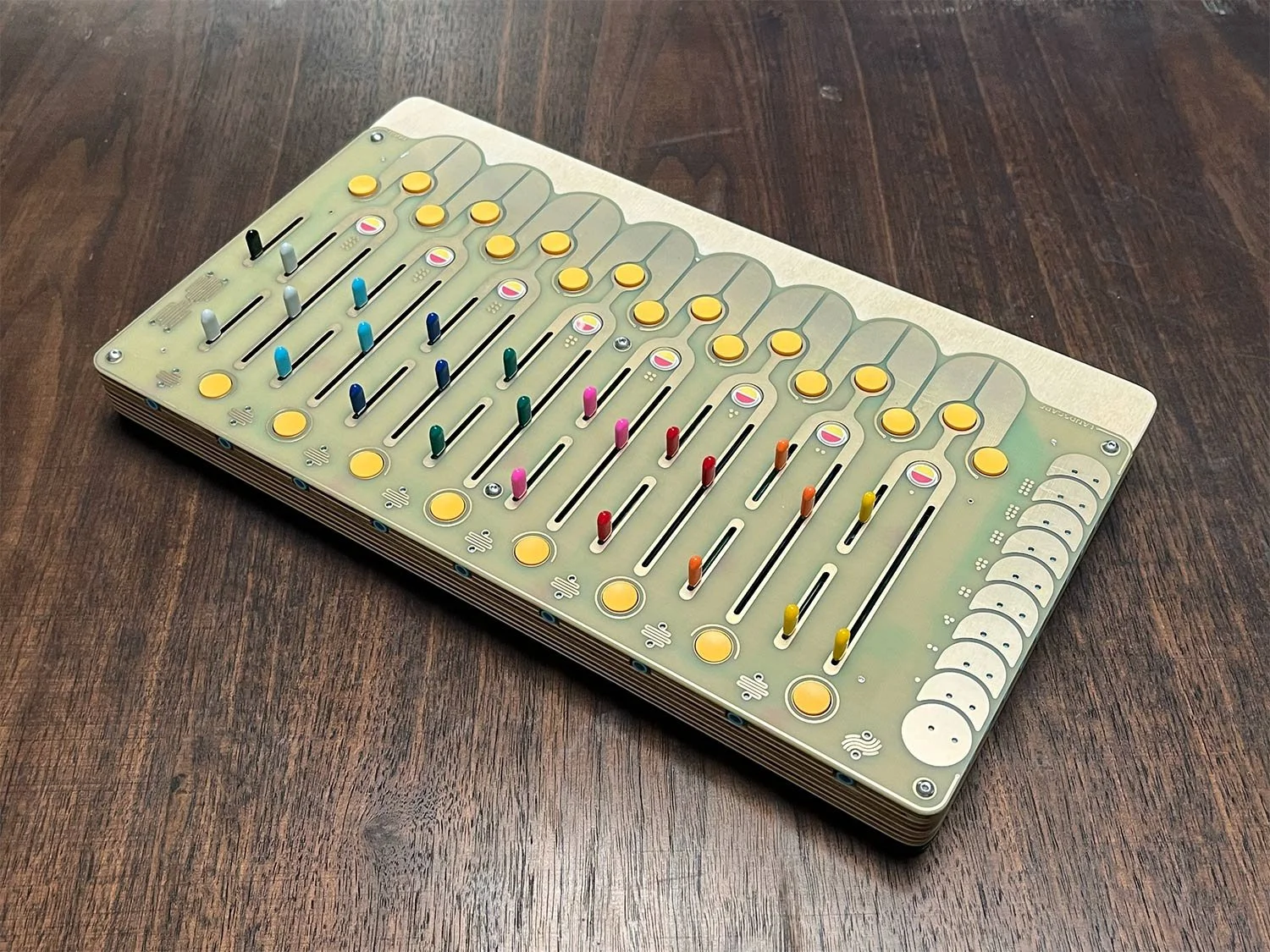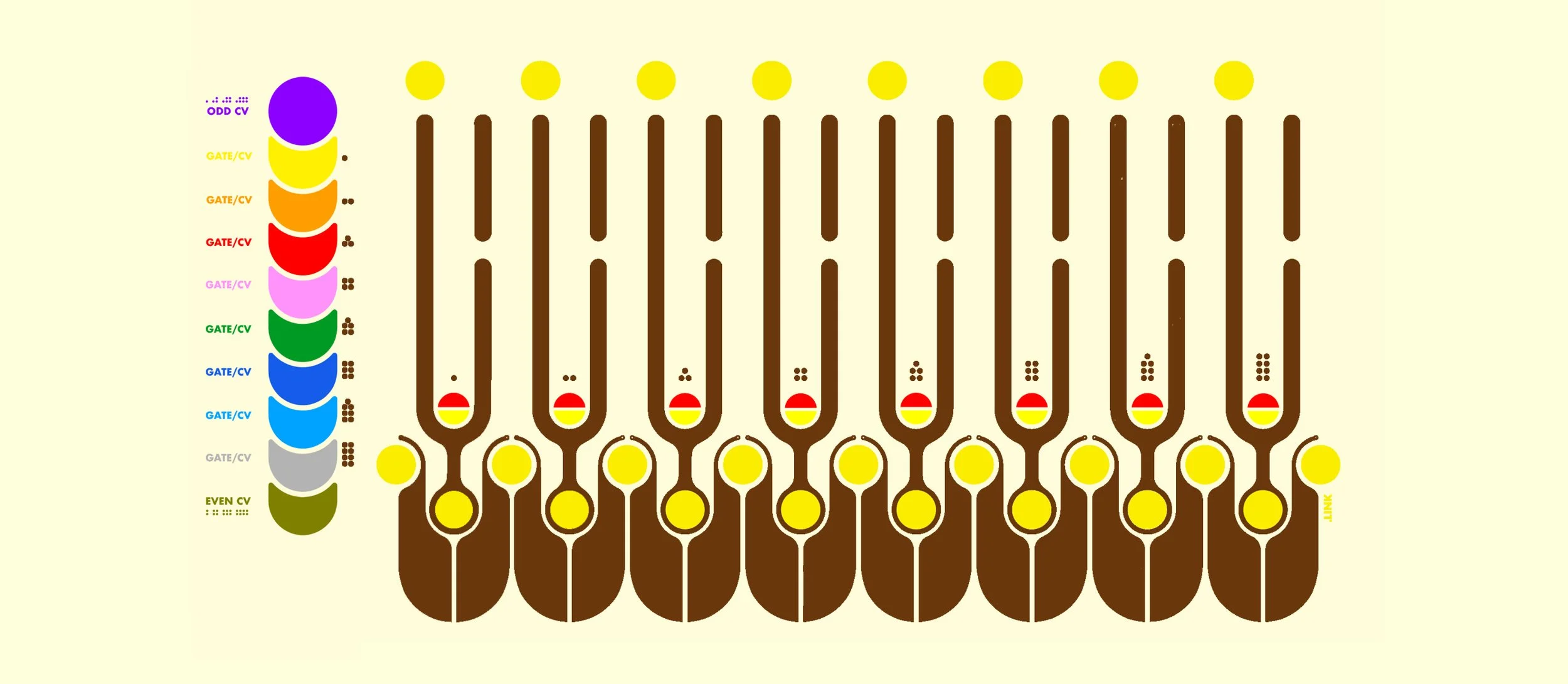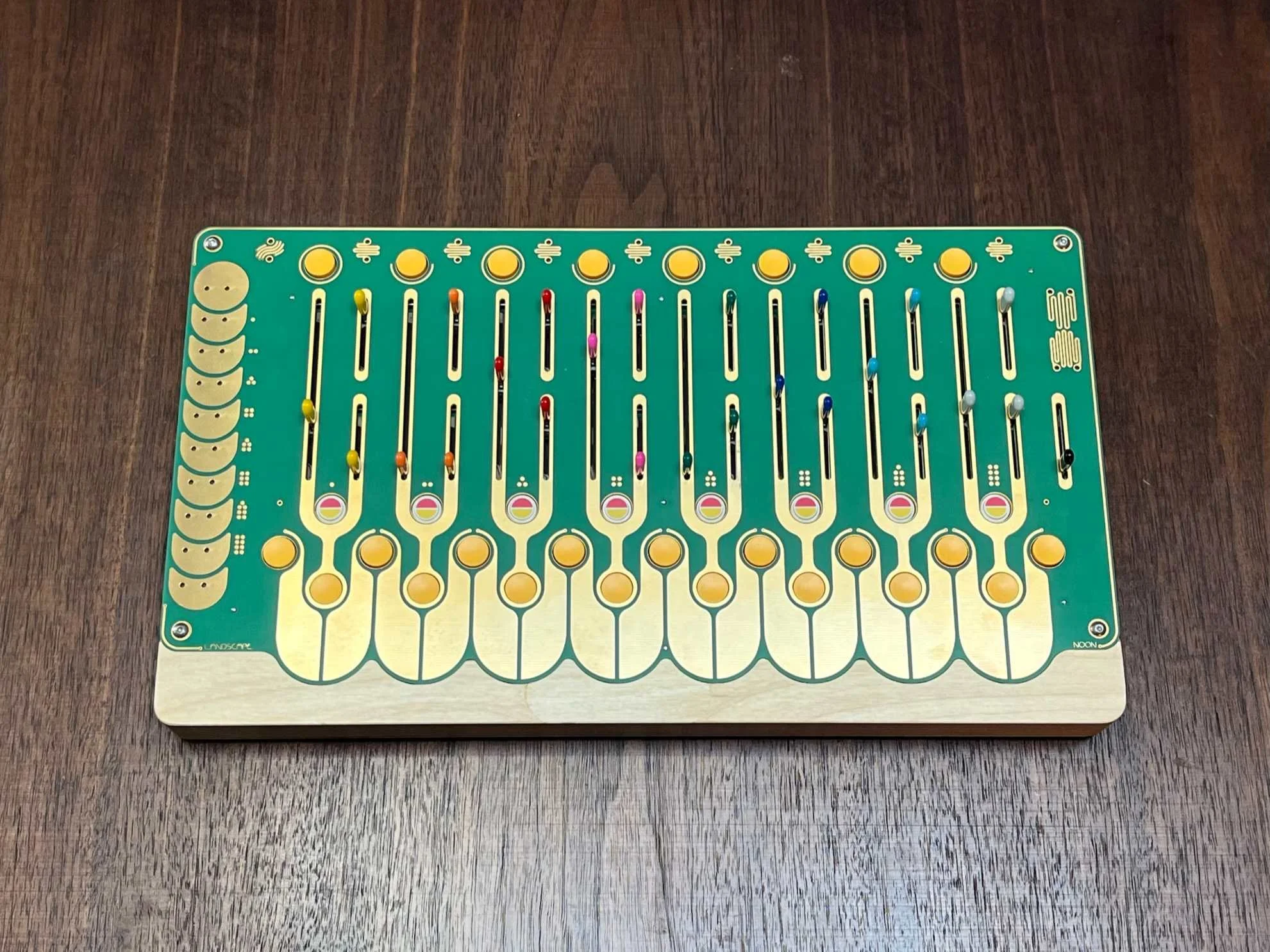NOON
Passive Analog 8-channel Rhythmic Instrument
In collaboration with Eli Pechman of Mystic Circuits
Activate and modulate Noon using voltage from external sequencers. No power supply needed. Analog circuits are powered momentarily by incoming gate and control voltage signals causing them to oscillate and move naturally. When Noon's channels are linked together, they grow, inform and process one another in complex rhythmic ways. Momentary power increases the unstable properties and organic textures of analog circuits. The immediacy of simple controls allows for rapid alterations without patching. Each of the eight channels is a unique analog circuit with its own characteristics.
$680
Download Manual | Ships within one week

-
get triggered and powered from incoming gates or CV (provided by voltage sequencers or modular systems)
increase the natural chaotic movement of electricity by removing the stabilizing elements of a constant power source
facilitate the sound of electronic circuits loading and unloading, powering up and powering down
access swing and groove through natural circuit-loading
deconstruct programmed rhythm sequences to make surprisingly new ideas
behave as a drum machine
behave as a textural drone instrument
dynamically and organically respond to different gate lengths on each channel, due to power loading characteristics of each circuit type
achieve movement and textural complexity normally associated with modular instruments and feedback patching
respond differently to an assortment of CV types (LFO, VCO, envelopes)
treat each unique channel as a “drum voice” or a chaotic “synth voice” (but more likely somewhere in between)
span touch plates with fingers, when using it as a drone instrument, to change pitch or texture
link and unlink channels to rhythmically vary modulation between them depending upon when each is receiving CV
-
Explore this visual
POWER: Noon is a powerless instrument which relies on receiving control voltage from external sources. A voltage sequencer, modular system or some form of external control voltage is required for use, and must be connected to any or all of Noon’s 8 channels. Using sequencers which have the ability to vary gate length is highly encouraged due to the increase in sound possibilities and rhythmic movement. Sequencers with USB power should be used with a USB wall adaptor because powering via a computer can create background noise in Noon.
CHANNELS: Each of the 8 channels, demarcated on the interface by vertical tuning fork shapes with color-coded sliders, features a unique analog circuit which is powered and controlled directly from its respective gate input (on the left side).
INPUTS: There are 10 inputs on Noon’s left side. The 8 center ones are gate inputs for powering each channel, corresponding to the number of dots on the interface. The top CV input powers/modulates the odd channels. The bottom CV input powers/modulates the even channels.
CV MUTE BUTTONS: Eight latching yellow CV Mute buttons (top row) allow for muting (button is up) or engaging (button is down) incoming CV from the Odd (top) or Even (bottom) CV inputs (but not from the other 8 channel inputs). These CV inputs are a way to add microtonal pitch changes and/or large textural movement to voices. The Even and Odd CV inputs are summed to their respective channels to provide a rhythmic modulation reference between multiple channels. This summing can create cross talk, audio bleed and unique interactions between even and odd channels when utilized.
SLIDERS: Each channel features a grouping of three color-coded slider controls: 1. main pitch/tone/texture (left) 2. secondary pitch/tone/texture (right bottom) 3. volume (right top)
VOLUME CONTROLS: In addition to the 8 individual volume controls for each channel, there is a main volume control on the right. Noon’s volume controls and mixing are done passively which can create non-linear behavior, compression, interaction between channels, audio bleed and at times additional chaos during droning patches.
LINK BUTTONS: There are 9 yellow link buttons (second row from the bottom, 7 located between every channel, plus one at either end of the interface, allowing the channel links to wrap back around, 1 → 8 or 8 → 1). These allow voltage sharing between channels. (When linked, powered channels will sometimes share voltage and partially activate unpowered channels.) Linking channels provides a wide mix of results depending on incoming voltage, active or inactive channels, slider settings, gate lengths and multichannel linking. The results can be described as cross modulation, growth (creating a larger and more complex circuit), or processing (filtering, distortion).
MOD BUTTONS: The eight yellow Mod buttons, located at the bottom of each tuning fork (bottom row), change the behavior and sound of each circuit. Having the button up or down allows for two different modes.
MUTE BUTTONS: There are eight dual-color Mute buttons (third row from bottom). When the button is down, gate or CV is received and the button will illuminate yellow. When muted (button is up) it will illuminate red. The intensity of illumination will change based upon how much voltage is being received. And for channel five, the position of the sliders will impact the LED’s brightness, due to voltage starving. To fully mute a channel the mute buttons should be utilized rather than the volume sliders, because the sliders will still allow some audio through at the lowest setting. The eight Mute buttons are post gate inputs which allow the channel to continue to effect or voltage share with a neighboring channel while they are linked.
TOUCH PLATES: There is a pair of Touch Plates at the bottom of each channel. Given the passive design of the device the reaction of the touch plates will vary greatly based upon what voltages are being received in which channel, how many channels are being touched, skin moisture and gate lengths. Using only trig signals can significantly lessen touch plate response to almost zero. The Touch Plates are designed for fingers to span two at a time for modulation. Using more fingers can send modulation between channels. The Touch Plates are more effective for use during drone patches. The Touch Plates along the left side are direct touch access to incoming CV and gate signals. During drone patching, use one finger on the left-side plates spanned with a finger on the bottom Touch Plates.
AUDIO INPUT: The external Audio Input (top left jack on back edge) is activated via the DOT/DUAL link button. This allows the link button to behave as a mute for incoming audio. External audio will mainly feed into the DUAL channel which can behave as a chaotic filter-feedback-distortion-VCA effect. The rhythm and tonality of the effect will vary greatly depending upon what type(s) of voltage you’re sending to DUAL.
OUTPUTS: There are individual outputs (DC coupled) for each channel located at the back edge of Noon. There are two additional outputs (AC coupled) on the right edge. When only the top output is used, all eight channels output there. If using both outputs on the right edge, the top is odd channels, and the bottom is even channels. If an individual output is used (top edge), the channel will be removed from the main outputs (right edge). The Main volume controls the right edge outputs.
PITCH: When a channel is treated as a “synth voice,” incoming CV will not create a volts per octave or a 12 tone response. Instead, expect microtonalities, and depending on the channel, large shifts in texture from note to note. Each channel will track pitch differently based on its slider settings. Pitch CV can also be used in the Gate inputs for additional behaviors.
DRONE: Active CV inputs can engage drone behavior in some channels. This drone behavior can grow in texture, movement and complexity as Link buttons are engaged. Use CV mute buttons along the top row to turn CV on or off. You can also use the gate inputs with held gates, voltage offsets, VCOs or LFOs to provide sustained drones.
-
Do not attempt to power Noon with anything other than a modular synthesizer or voltage sequencer.
Clean with a lightly damp (water only) cotton cloth. If a deeper clean is needed, you might try a small amount of rubbing alcohol, but never on the wooden case.
-
Dimensions: 32cm x 18cm x 2.5cm / 12.5” x 7” x 1”
Weight: 0.9 kg. / 2 lbs.
Materials: Gold plated PCB (2mm fiberglass) + routed Birch plywood case with clear coat + metal shaft sliders with rubber caps + concave and dual LED latching push buttons
CV Inputs: 10 x 3.5mm jacks
Audio Input: 1 x 3.5mm jack
Audio Outputs: 10 x 3.5mm jacks
-
Each voltage sequencer will have different effects on the tonality of the Noon due to differences in power and feature sets.
Strongest recommendations:
Arturia Beatstep Pro
Eurorack modular systems
Sequencers/Control voltage sources that work well:
Ableton Push 3
Acid Rain Technology Constellation
ALM Busy Circuits Pamala’s Workout
Arturia Beatstep Pro & Keystep Pro
ET Levit8
Expert Sleepers ES-9 & FH-2
Five12 Vector Sequencer
Frap Tools Falistri
Lorre Mill Double Knot
Make Noise 0-ctrl
Making Sound Machines Stolperbeats
Mannequins Just Friends
Meng Qi Voltage Memory
monome teletype + meadowphysics
Motu Ultralight as CV interface
MPC One
Music Thing Turing Machine + Pulses mkii
Mutable Instruments Marbles & Stages
OXI One
Polyend Poly 2
Qu-Bit Contour
Schlappi Engineering Angle Grinder
Sequentix Cirklon w/ CVIO
Shakmat Four Bricks Rook
Sixty Four Pixels CV.OCD
Social Entropy Engine
Soma Ornament-8
Soma Pulsar-23
Squarp Hermod
Tiptop Audio Trigger Riot
vpme.de Euclidean Circles v2
Westlicht Per Former
WMD Metron
⌘various audio rate oscillators
Sequencers/Control Voltage sources that only activate some Noon voices well, most likely due to lower power:
Korg SQ-64 (using a Volca power supply and updating to the newest firmware is a big help)
Synthstrom Deluge
Torso T-1
*We continue to post more examples of working/non-working relationships as we get access to more equipment and learn from users. Thank you for all the suggestions so far!
-
“STEREO”: If using both main outputs (even and odd) while Channel Link buttons are engaged, strange stereo imaging can occur, because of modulation and voltage sharing between Even & Odd Channels.
COMPRESSION EFFECTS: The passive mix of the main outputs (even and odd) can create competition between channels, resulting in compression behavior.
RHYTHMIC COMPLEXITY: When using incoming CV along with rhythmic gate signals, a singular voice can achieve the illusion of multiple rhythmic elements.
INTERNAL PROCESSING: You can use a patch cable to feed any channel’s individual output back into the external audio input (left jack on top edge) to be processed by engaging the DOT/DUAL link button and activating channel two.
CHANNEL 5: Cympath works, in part, by voltage starving. If the sliders are further down, the signal will be lower in pitch, quieter, and the LED on the mute switch will be dim. Turn down individual volumes of surrounding channels to provide additional headroom.
CHANNELS 7 & 8: The Larynx & Bacid channels will give best results being fed gate and CV voltage simultaneously. Sending trigs instead of gates to these channels may have less interesting results.
VOLTAGE TYPES: Short envelopes sound very nice and you can even send LFOs or VCOs for highly textured results or droning behavior.
OUTPUTS: Use the individual outputs for additional control of volume and noticeable clarity, if using individual channels on a mixer.

1-8 Channel Sounds Audio Samples
-
knock/tap/flutter/feedback/filter/saw/divide
-
clicks/pings/liquid/boom/sine/palms/filter
-
hollow/laser/wood/thud/phased
-
stretch/wrap/static/wet/squish
-
metal/strike/harmonic/scream/crumble
-
avian/atonal/rough/angular
-
vocal/round/squeal/bubble
-
bass/slam/acidic/microtone
Audio Samples
Video Samples







